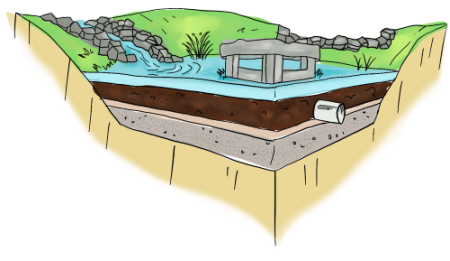
The Highlights:
-
-
Compost is used for stormwater management
-
Functions at a high quality level
-
Uses natural resources to remove sediment and chemical contaminants
-
Releases nutrients into soil, meaning less need for additional fertilizers
-
One of the many applications of compost can be found through a substance called bioretention media, which is primarily used for stormwater management. This material is made by blending compost into a sand-based media, which is then used to capture and release water.
The benefits of this material make it not only a great way to utilize compost, but allow for a high quality and natural process for stormwater management. The media is used to capture the sheet flow generated water in a way that increases the cation exchange capacity, thus removing sediment and chemical contaminants in a highly effective manner. The enhanced microbial processes better degrade petroleum hydrocarbons and improve vegetation establishment and long-term sustainability. Functionally, the compost blend has the unique ability to hold a substantial amount of water which means that irrigation requirements for stormwater management can be limited. The process also allows for the slow release of nutrients into soil which essentially eliminates additional fertilization for about 1-2 years.
Currently compost is a requirement for bioretention media in various communities and stormwater management agencies. Construction for use of this material involves pre-treatment of the water flow to remove excess debris. The biotreatment area must be excavated, and where an inch of water is required to drain, a 4 to 6-inch perforated pipe would be installed, surrounded by about 6 to 10-inches of pea gravel/stone. A basin will be then filled with compost using a telebelt or slinger truck. The bioretention media would contain around 20 to 40% compost, and 80 to 60% respectively of coarse sand. Typically the sand used for this will measure around 0.02 inches to 0.04 inches, and will be graded based on the goals of a particular objection of a bioretention mechanism.
Regardless of the aims of the treatment system, the compost used will be stable, containing low levels of mobile nitrogen and phosphorus. As mentioned, the fact that the compost is so nutrient-dense allows for pre-plant fertilization to be highly reduced if not completely avoided. After the facility is complete, plants will be placed to help bind and uptake pollutants, remove water through evapo-transpiration, and encourage infiltration.
The result of this will be a stormwater treatment facility that works naturally, functionally, and looks pleasing to the eye – all with the help of composting!
Some of the information in this article came from the Compost Research & Education Foundation's Compost Use Applications - A Return on Investment (ROI) factsheets. The full set of factsheets can be found here.

